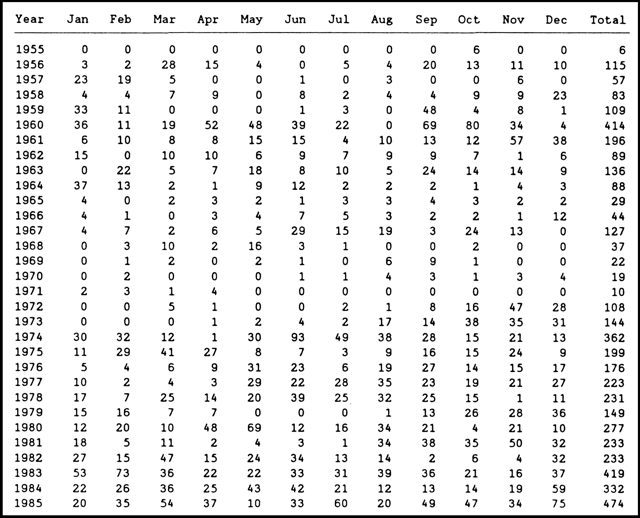Report on Aira (Japan) — November 1985
Scientific Event Alert Network Bulletin, vol. 10, no. 11 (November 1985)
Managing Editor: Lindsay McClelland.
Aira (Japan) Vigorous explosions continue
Please cite this report as:
Global Volcanism Program, 1985. Report on Aira (Japan) (McClelland, L., ed.). Scientific Event Alert Network Bulletin, 10:11. Smithsonian Institution. https://doi.org/10.5479/si.GVP.SEAN198511-282080
Aira
Japan
31.5772°N, 130.6589°E; summit elev. 1117 m
All times are local (unless otherwise noted)
Eruptive activity remained vigorous in November, when 34 explosions were recorded. Frequent powerful explosions produced air shocks and scattered incandescent blocks to about 2 km from the summit. No damages were reported. An explosion on 25 November at 1427 was accompanied by a small pyroclastic flow, which only covered part of the summit area.
The frequency of explosions increased further in early December. By the 5th, 19 explosions were recorded, bringing 1985's total to 416, the largest since discrete explosive activity began in 1955 (figure 15). A series of small explosions on 3 December shattered windows of several buildings in northern Kagoshima and disrupted telephone service in some areas. The summit crater of Minami-dake erupted on 5 December at 0220 and 0648, dropping ash on Kagoshima, but there was no damage.
 |
Figure 15. Summary table of monthly and yearly number of explosions at Sakura-jima since the summit eruption began in 1955. Courtesy of JMA. |
Geological Summary. The Aira caldera in the northern half of Kagoshima Bay contains the post-caldera Sakurajima volcano, one of Japan's most active. Eruption of the voluminous Ito pyroclastic flow accompanied formation of the 17 x 23 km caldera about 22,000 years ago. The smaller Wakamiko caldera was formed during the early Holocene in the NE corner of the caldera, along with several post-caldera cones. The construction of Sakurajima began about 13,000 years ago on the southern rim and built an island that was joined to the Osumi Peninsula during the major explosive and effusive eruption of 1914. Activity at the Kitadake summit cone ended about 4,850 years ago, after which eruptions took place at Minamidake. Frequent eruptions since the 8th century have deposited ash on the city of Kagoshima, located across Kagoshima Bay only 8 km from the summit. The largest recorded eruption took place during 1471-76.
Information Contacts: JMA, Tokyo; UPI.

